Recombinant Rhesus monkey RPS3 Protein, His-tagged
| Cat.No. : | RPS3-4025R |
| Product Overview : | Recombinant Rhesus monkey RPS3 full length or partial length protein was expressed. |
- Specification
- Gene Information
- Related Products
- Case Study
- Application
- Download
| Species : | Rhesus macaque |
| Source : | Mammalian Cells |
| Tag : | His |
| Endotoxin : | < 1.0 EU per μg of the protein as determined by the LAL method. |
| Purity : | >80% |
| Notes : | This item requires custom production and lead time is between 5-9 weeks. We can custom produce according to your specifications. |
| Storage : | Store it at +4 ºC for short term. For long term storage, store it at -20 ºC~-80 ºC. |
| Storage Buffer : | PBS buffer |
| Gene Name | RPS3 ribosomal protein S3 [ Macaca mulatta (Rhesus monkey) ] |
| Official Symbol | RPS3 |
| Synonyms | RPS3; 40S ribosomal protein S3; |
| Gene ID | 695748 |
| mRNA Refseq | NM_001266290 |
| Protein Refseq | NP_001253219 |
| MIM | |
| UniProt ID | F7A782 |
| ◆ Recombinant Proteins | ||
| RPS3-6890H | Recombinant Human Ribosomal Protein S3, His-tagged | +Inquiry |
| RPS3-1106H | Recombinant Human RPS3 protein, His-tagged | +Inquiry |
| RPS3-2481F | Recombinant Fruit Fly RPS3 Protein (1-246 aa), His-tagged | +Inquiry |
| RPS3-2532C | Recombinant Chicken RPS3 | +Inquiry |
| RPS3-4025R | Recombinant Rhesus monkey RPS3 Protein, His-tagged | +Inquiry |
| ◆ Cell & Tissue Lysates | ||
| RPS3-563HCL | Recombinant Human RPS3 lysate | +Inquiry |
Case 1: Kim Y, et al. Oncotarget. 2016
Ribosomal protein S3, known as rpS3, is a component made up of 243 amino acids and is part of the 40S ribosomal small subunit. Interestingly, rpS3 is specifically secreted by cancer cell lines. Recent mass spectrometry analysis has shown that rpS3 is glycosylated at the Asn165 residue. A mutation at this specific site has been found to reduce the secretion of rpS3 in cancer cells. The secretion process is hindered by Brefeldin A, which disrupts the transport from the endoplasmic reticulum (ER) to the Golgi apparatus, and by Tunicamycin, a compound that inhibits N-linked glycosylation. It has been confirmed that the N-linked glycosylation of rpS3 is essential for its secretion into the culture medium through the ER-Golgi pathway. The presence of glycosylation is further supported by the binding of rpS3 to Concanavalin A, a lectin that recognizes carbohydrates, and the shift in molecular weight of the secreted rpS3 upon treatment with peptide-N-glycosidase F. Moreover, the N165G mutation in rpS3 results in decreased secretion levels compared to the wild-type protein. Additionally, an in vitro binding assay has identified that rpS3 forms homodimers through interactions in its N-terminal region (amino acids 1-85) and a middle region (amino acids 95-158).
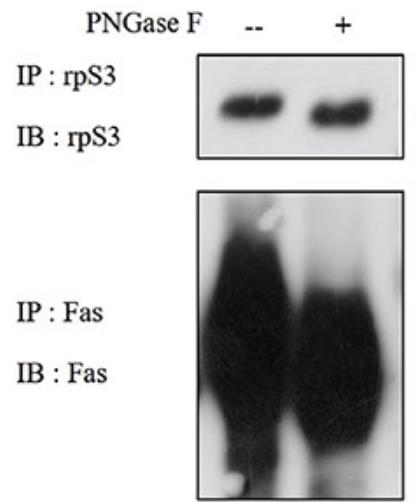
Fig1. The secreted rpS3 was glycosylated, as revealed by a slight downward shift of the protein band after digestion with PNGase F.
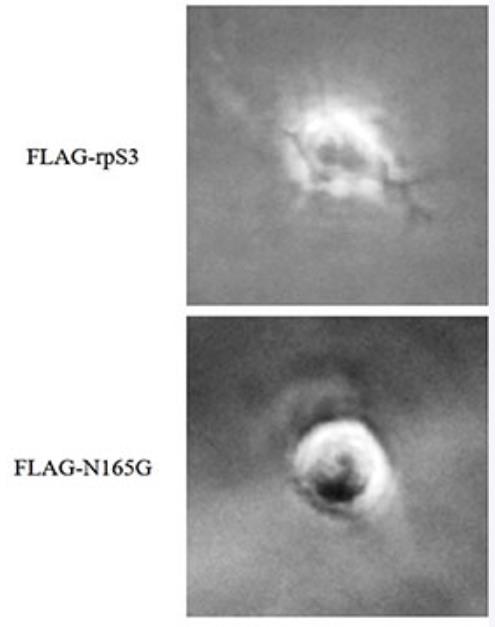
Fig2. HT1080 cancer cells that stably expressed FLAG-rpS3 or FLAG-N165G were used for 3D culture assays to identify reduction of the invasiveness phenotype.
Case 2: Koch B, et al. J Biol Chem. 2012
In yeast, the rapid synthesis of 2000 ribosomes per minute is essential, necessitating swift production of ribosomal proteins, their efficient transport to the nucleus, and proper assembly into ribosomal subunits to maintain peak growth rates. This study reveals that the ankyrin repeat protein Yar1 forms a direct interaction with the small subunit ribosomal protein Rps3, escorting the newly made Rps3 from the cytoplasm into the nucleus for its integration into pre-ribosomal particles. A yeast strain lacking the yar1 gene exhibits a phenotype akin to that of an rps3 mutant, characterized by a buildup of 20S pre-rRNA and a defect in the export of the 40S subunit. The simultaneous presence of an rps3 mutation and a yar1 deletion intensifies these phenotypes, whereas elevating the expression of RPS3 mitigates the deficiencies observed in a yar1-deficient strain. Additionally, the findings indicate that Yar1 shields Rps3 from forming aggregates in vitro and enhances its solubility within the cell.
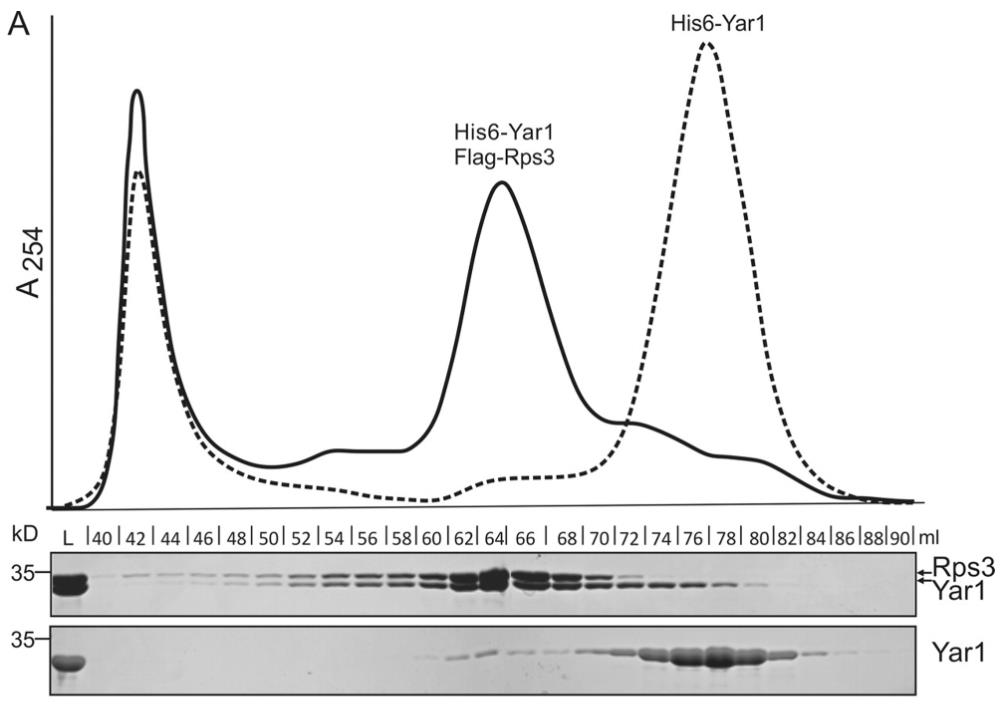
Fig1. Yar1 and Rps3 interact in vitro.
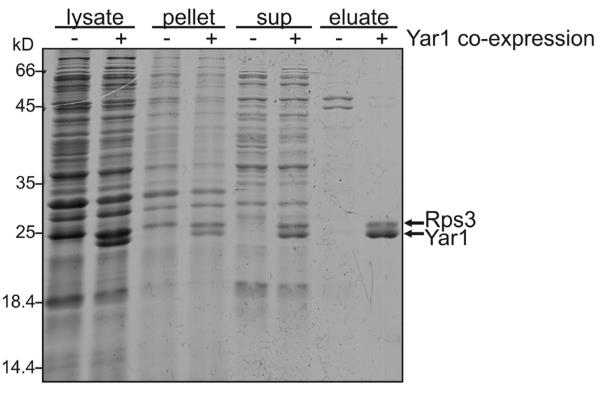
Fig2. Rps3 expressed in E. coli is only soluble upon co-expression of Yar1.
As a component of ribosome, RPS3 is involved in protein synthesis and is an indispensable part of protein translation in cells. RPS3 has the function of repairing DNA damage, especially when the cell is subjected to oxidative stress, it is able to accumulate DNA repair in the mitochondria through interactions with HSP90, HSP70 and TOM70. RPS3 is also involved in the innate immune response of cells to bacterial infections, and certain bacterial pathogens suppress the host's immune defenses by interfering with the function of RPS3.
The rhesus RPS3 protein, if it has unique biological activity, may be used to develop diagnostic methods for specific diseases. Its specificity may make it an important tool for studying certain biological processes or mechanisms, for studying protein structure and function, signaling, and cell interactions.
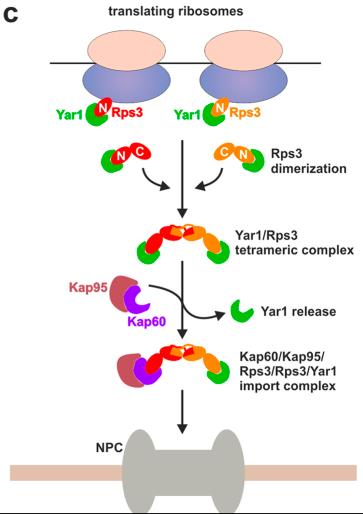
Fig1. Model describing the formation of the Yar1/Rps3/Rps3/Kap60/Kap95 import-complex that allows simultaneous targeting of an Rps3 dimer bound to one Yar1 chaperone into the nucleus. (Valentin Mitterer, 2016)
Not For Human Consumption!
Inquiry
- Reviews
- Q&As
Ask a Question for All RPS3 Products
Required fields are marked with *
My Review for All RPS3 Products
Required fields are marked with *
Inquiry Basket


